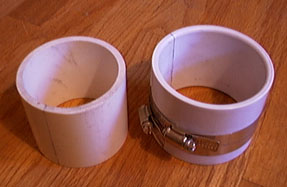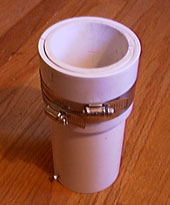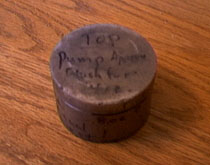
Retrieved: 12/28/2014
This powder die design was invented by Lloyd Sponenburgh. In fact, this die was even made by Lloyd because I bought it from him when he was still in the business of selling BP making tools. Unfortunately, Lloyd no longer sells this useful item, but you can fairly easily make your own. He has, however, described how he makes them in the pyro news group. I assume he won't mind if I do the same on this web page.

This is the base of the powder die. It consists of a five inch length of 3 inch I.D. PVC and a base cylinder of cast resin. The cylinder looks a little blotchy because of black powder stain and is quite heavy because of its length. The only utility of this exaggerated length is the avoidance of excessive blocking if you use a press with high clearance. A much shorter, lighter base would still work just fine. Notice that the PVC sleeve is held fixed, relative to the base cylinder, by a set screw. The function of this sleeve is to position the cylinder a defined distance into the compression sleeves pictured below.

The compression sleeves are made from a 3 inch length of 3 inch I.D. PVC and a "repair sleeve". The repair sleeve is similar to a coupler, except it has no stop ridge in the center. Both of these sleeves have been split by cutting with a very narrow kerf blade down the length of the sleeve. In use, one sleeve fits inside the other, with the splits opposite each other, and they are restrained from expansion by two common pipe clamps.

When placed on the base, the compression sleeves form the walls of the chamber where black powder meal is placed to be pressed.

The top piston is another cylinder, similar to the base cylinder, which has been made from a casting of resin. Read the feedback at the bottom of the page from Lloyd to find out about how to make these castings.

The top piston is placed into the compression sleeves after the black powder meal and pressed until a known density has been achieved. On this top piston, a groove has been placed to indicate that when it is even with the top of the compression sleeves, 8 ounces of meal will be at the desired density of 1.7 grams per cubic centimeter. Likewise, 4 ounces of meal are pressed until the top of the piston is flush with the top of the sleeves. The press cake that results from this pressing process will be very hard and sounds like china when tapped. After corning, you will have a very durable, hard grained powder.
Dan,
I'll gladly supply the composite formula for you, but when you hear it, you'll DIE of laughter.
I wanted something that would both lower the cost of the resin casting and provide a strong matrix. Chopped fibers were out for cost, and organic fillers for lack of strength. I settled on 'sharp sand'. No kidding!! It's called sharp sand in some circles, mason's sand in others. SackCrete Corp. puts it up as 'fine blasting sand'. River sand is smooth, and makes a weak matrix. Add sand to mixed polyester resin (fiberglass resin) until it makes a very thick but still pourable batter. If I recall (without my docs book in hand) about 24 fl.oz. of resin to one quart dry measure of sand works out about right. I cut back to about 60% of the recommended hardener, because the large castings get very hot, and will crack as they cure if you add too much hardener. You want enough sand so that no resin 'settles out' to the top after you fill your forms. The ratio is fairly critical, but quite easy to discern. If liquid resin rises to the top after pouring, you need more sand next time. DO make sure your moulds are accurate. You'll never cut this stuff after it's cured. The silica makes ALL metal tools go bye-bye on the first contact. I had to mill the calibration grooves in my pistons with a solid carbide bit, and that had to be sharpened every two or three cuts.
I mix vaseline with toluene as a mould release, and simply paint on a VERY thin layer with a soft bristle brush. The vaseline will melt with the heat of the casting, so go sparingly, or you'll have a puddle of grease on your resin as it cures. My moulds were cleaned-up pieces of PVC DWV pipe clamped to a foil-covered piece of aluminum plate. The resin shrinks slightly on cure, and the castings just slipped out without any difficulty. But if a casting stuck, I could unclamp the pipe from the base plate, and push the casting out from one end.
Lloyd
Dec. 11, 1998 From Dan Williams
Due to several requests for exact dimensions, I have added the discussion below to clarify the design of the powder die.
The top piston ram is 5.36cm high.
The 8 oz. mark is 1.46 cm below the top.
The base cylinder enters the compression sleeves by 0.8cm.
Now for the math just to verify the theory. The compression sleeves are 3 in. or 7.62cm long.
Subtracting the size of the top ram and base intrusion:
7.62 - 5.36 - 0.8 = 1.46 cm for a 4 oz. BP cake and 2.92 cm for an 8 oz. cake. These are the cylinder lengths (L) for each cake.
The volume of a cylinder is (PI * (D/2)**2) * L where D is the diameter and L is the length.
For the 8 oz. cake this becomes 3.14 * 14.516 * 2.92 = 133.16 cc.
Since 8 oz = 226.8 grams, the density becomes 226.8/133.16 = 1.703 grams/cc.
It works!
Hey Dan,
I finished the BP Die design program this morning. I have written this program for you and all who wish to use it. If you feel this program worthy I will leave this link for all to download or feel free to add the program to your URL or what ever pleases. I can a dd or change any function. Just let me know. The program is 780k. The link is: www.amasa.com/BPdie.exe Thanks, Mike